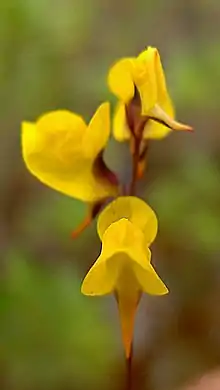Utricularia juncea
Utricularia juncea, the southern bladderwort,[1] is a small to medium-sized, probably perennial carnivorous plant that belongs to the genus Utricularia. U. juncea is native to Central, South, and North America. It grows as a terrestrial plant in marshes, swamps, and pools in shallow waters, mostly at lower altitudes. It was originally described and published by Martin Vahl in 1804.[2]
| Utricularia juncea | |
|---|---|
 | |
| Scientific classification | |
| Kingdom: | Plantae |
| Clade: | Tracheophytes |
| Clade: | Angiosperms |
| Clade: | Eudicots |
| Clade: | Asterids |
| Order: | Lamiales |
| Family: | Lentibulariaceae |
| Genus: | Utricularia |
| Subgenus: | Utricularia subg. Bivalvaria |
| Section: | Utricularia sect. Stomoisia |
| Species: | U. juncea |
| Binomial name | |
| Utricularia juncea | |
Synonyms
- Personula grandiflora Raf.
- Stomoisia juncea (Vahl) Barnhart
- S. virgatula (Barnhart) Barnhart
- Utricularia angulosa Poir.
- U. cornuta var. michauxii Gomez
- U. juncea f. minima S.F.Blake
- U. juncea f. virgatula (Barnhart) Fernald
- U. personata Leconte ex Elliott
- U. sclerocarpa Wright ex Sauvalle
- U. simplex Wright ex Sauvalle
- U. stricta G.Mey.
- U. virgatula Barnhart
See also
References
- USDA, NRCS (n.d.). "Utricularia juncea". The PLANTS Database (plants.usda.gov). Greensboro, North Carolina: National Plant Data Team. Retrieved 2008-12-28.
- Taylor, Peter. (1989). The genus Utricularia - a taxonomic monograph. Kew Bulletin Additional Series XIV: London.
This article is issued from Wikipedia. The text is licensed under Creative Commons - Attribution - Sharealike. Additional terms may apply for the media files.